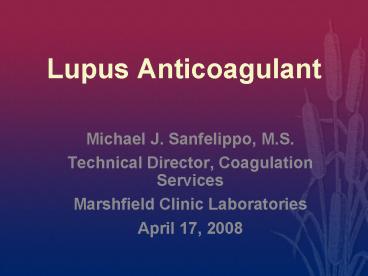Lupus Anticoagulant - PowerPoint PPT Presentation
1 / 23
Title:
Lupus Anticoagulant
Description:
More laboratory tests-dilute Russell's Viper Venom Time and Platelet Neutralization. ... Dilute Russell's Viper Venom Time (DRVVT) Hexagonal Phase Assay (StaClot LA) ... – PowerPoint PPT presentation
Number of Views:2102
Avg rating:3.0/5.0
Title: Lupus Anticoagulant
1
Lupus Anticoagulant
- Michael J. Sanfelippo, M.S.
- Technical Director, Coagulation Services
- Marshfield Clinic Laboratories
- April 17, 2008
2
Historical Perspective
- 1954
- Conley Hartman observed inhibition in vitro
- 1960s Mayo Clinic
- Observed Inhibitor Associated w/Thrombosis
- 1970s
- Inhibitor considered lab nuisance reagent
manufacture made reagents unresponsive to
Inhibitor - 1972
- Lupus Anticoagulant term used by Feinstein and
Rapaport - 1976
- Test developed to demonstrate inhibition of
phospholipid tissue factor inhibition.
3
Historical Perspective (contd)
- 1980s
- Development of ELISA assay to demonstrated
antibody to cardiolipin. - More laboratory tests-dilute Russells Viper
Venom Time and Platelet Neutralization. - Recognition of LA as risk factor for spontaneous
abortion. - Recognition of risk factor for arterial and
venous thrombosis. - Identification of mechanisms of thrombosis
- Recognition of antiphospholipid syndrome
4
Definition of Lupus Anticoagulant
- Antibody directed against protein-bound
phospholipid which delays in vitro coagulation
without a bleeding tendency but associated with
significant thrombotic risk.
5
Nature of the Antibodies
- Real antigen is B2-glycoprotein I (B2GPI).
- Protein binding to negatively charge surface
exposes antigenic sites. - Some antibodies bind to B2GPI directly.
- Antibodies may react with other proteins most
frequently prothrombin.
6
Other Phospholipid Binding Proteins
- Antiphospholipid antibodies may also be directed
against - Protein C
- Protein S
- Annexin V
- High Molecular Weight Kininogen
- Factor XI
7
How do APA affect Coagulation in vitro?
- Antibody complexes with B2GPI or prothrombin have
high affinity for phospholipids - Complexes compete with coagulation factors for
catalytic surfaces.
8
Proposed Mechanisms of Thrombosis
- Impaired Fibrinolysis
- Inhibition of Protein C and S system
- Inhibition of Prostacyclin release from
endothelial cells - Inhibition of Annexin V Tissue Pathway Down
Regulation - Inhibition of B2GPI may affect Protein S
9
Pathology Associated with APLS
- Arterial thrombosis
- Venous thrombosis
- Recurrent spontaneous abortion
- Catastrophic APLS
10
Diagnostic Criteria of the APLS
- Vascular Thrombosis
- One or more episode venous or arterial thrombosis
- Complication of Pregnancy
- Fetal death
- Premature birth
- Recurrent spontaneous abortion
- Laboratory Criteria
- Anticardiolipin antibodies
- Lupus Anticoagulant
11
Laboratory Tests
- APTT
- Dilute Russells Viper Venom Time
- Hexagonal Phase Assay
- ELISA Assays
- Anticardiolipin Antibody
- Anti Beta-2 Glycoprotein I Antibody
- Sero-negative
12
Criteria for Lupus Anticoagulant
- Prolongation of one or more assays that are
phospholipid dependent. - Evidence that test plasma is acting as an
inhibitor on normal plasma. - Evidence that inhibitory activity is phospholipid
dependent.
13
Bleeding Complications with APLS
- Thrombocytopenia
- Qualitative Platelet Defect (Renal Failure)
- Prothrombin Deficiency
- Spontaneous Inhibitor to Factor VIII
14
Catastrophic APLS
- Evidence of involvement three or more organs,
systems, or tissues. - Development of manifestation in one week or less.
- Confirmation of small vessel occlusion by
histopathology. - Lab identification of LA or antiphospholipid
antibodies.
15
Association of Antiphospholipid Syndrome (APLS)
with other Conditions
- APLS has been associated with the following
conditions - Systemic Lupus Erythematosis (SLE)
- Other autoimmune diseases
- Recurrent spontaneous abortion
- Hepatic vein thrombosis
- Malignancy
- Infectious Diseases
16
Drug Induced Antiphospholipid Syndrome
- There are several drugs that have been
associated with drug induced SLE and the
antiophospholipid syndrome. They are as follows - 1. Procainamide
- 2. Phenothiazines
- 3. Chlorpromazine
- 4. Hydralazine
- 5. Quinine and Quinidine
- 6. Some antibodies
- Many of these drugs are not in common use at
this time.
17
Laboratory Tests for APLS
- Coagulation Tests for APLS
- APTT and PT
- Dilute Russells Viper Venom Time (DRVVT)
- Hexagonal Phase Assay (StaClot LA)
- Tissue Factor Inhibition (Dilute Prothrombin
Time) - ELISA Methods
- Anticardiolipin Antibody IgG, IgM, IgA, Anti
Beta-2 Glycoprotein I Antibody, IgG, IgM, IgA
18
Treatment of APLS
- Treatment of APLS
- Thrombotic complications
- Spontaneous abortion heparin
- Venous or arterial thrombosis warfarin long
term - Associated Factor VIII Inhibitor
- Replacement support (VIII concentrates)
- Immunosupression rituximab and cyclophosphamide
19
Problems with Anticoagulant Therapy
- Problems with Anticoagulant Therapy
- Monitoring Heparin (unfractionated)
- Prolonged initial APTT
- Use specific Heparin Assay
- Monitoring Warfarin
- Prolonged initial PT
- Measure Factor VII and X
- Erratic PT in reliable patient
- Measure Factor X with chromogenic assay
- Problem in 6.5 of patients with Lupus
Anticoagulant
20
Case of False Elevation of INR in Patient with
Lupus Anticoagulant
- A 66-year-old male was referred for study
because he was continuing to have transient
ischemic attacks while on Warfarin with an INR of
approximately 2.0. - Lab results at 1 mg qd.
- INR 1.83 Factor X 131
- Lab results at 3 mg qd.
- INR 2.55 Factor X 67
- Lab results at 4 mg qd.
- INR 4.84 Factor X 31
- Therapeutic range
- INR 2.0 3.5 Factor X 43 - 17
21
Case History 1
- 19-year-old female with venous thrombosis.
Patient admitted with hot, swollen left leg. Past
history or false positive VDRL.
22
Case History 2
- 35-year-old nurse complained of vision changes
and headaches. Neurologic exam suggested
thrombosis of retinal vein.
23
Case History 3
- 38-year-old white female referred for study due
to a history of three spontaneous abortions.
Patient had no history of thrombosis or bleeding
tendency. The family history was also negative.

